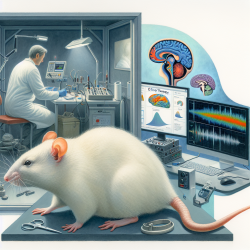Introduction
Parkinson’s disease (PD) is a progressive neurological disorder affecting millions worldwide. Among its symptoms, vocal deficits such as hypokinetic dysarthria significantly impair communication and quality of life. Despite the prevalence of these vocal issues, treatment options remain limited due to a lack of understanding of their pathological mechanisms. Recent research using rat models has provided valuable insights into these mechanisms, offering potential pathways for improved therapeutic interventions.
Understanding Vocal Deficits in PD
Vocal deficits in PD are characterized by decreased loudness, monotone pitch, and reduced intelligibility. These issues stem from complex pathologies that differ from the motor symptoms traditionally associated with PD. While pharmacological treatments targeting dopamine pathways have shown limited efficacy in addressing vocal deficits, behavioral therapies remain the gold standard. However, a deeper understanding of the biological underpinnings is crucial for developing more effective interventions.
Rat Models: A Gateway to Understanding
Rat models have been instrumental in studying PD-related vocal deficits. These models allow researchers to explore disease-specific mechanisms and evaluate the effects of various interventions. The study of ultrasonic vocalizations (USVs) in rats, which are analogous to human vocal communication, has shed light on the changes that occur in PD. USVs, produced by the larynx and modulated by airflow, serve as a valuable tool for assessing vocal sensorimotor control in PD models.
Key Findings from Rat Models
- Neurotoxin Models: The 6-hydroxydopamine (6-OHDA) model induces dopamine depletion, mimicking PD symptoms. Studies have shown that 6-OHDA lesions lead to decreased call intensity and complexity in USVs, mirroring the hypophonia seen in PD patients. Exercise and pharmacotherapies have shown potential in rescuing these deficits, highlighting the importance of combined interventions.
- Alpha-Synuclein Overexpression Models: These models focus on the accumulation of misfolded proteins, a hallmark of PD pathology. Research indicates that overexpression of alpha-synuclein leads to reduced call intensity and rate in USVs, suggesting that protein aggregation plays a role in vocal deficits.
- Genetic Models: The DJ1-/- and Pink1-/- models explore genetic mutations linked to PD. These models have demonstrated early and progressive vocal deficits, providing insights into the neurobiological changes underlying voice dysfunction. Notably, these models highlight the involvement of extra-dopaminergic systems in vocal impairments.
Implications for Practitioners
For practitioners working with PD patients, understanding the outcomes of these studies can enhance therapeutic approaches. Implementing targeted exercise programs and exploring pharmacological options could improve vocal outcomes. Additionally, further research into the specific pathways involved in vocal deficits could lead to more personalized and effective treatments.
Conclusion
Rat models have significantly contributed to our understanding of vocal deficits in PD. While no single model fully captures the complexity of the disease, each offers unique insights into the mechanisms at play. By continuing to explore these models, researchers and practitioners can work towards more effective interventions, ultimately improving the quality of life for individuals with PD.
To read the original research paper, please follow this link: Rat Models of Vocal Deficits in Parkinson’s Disease.










